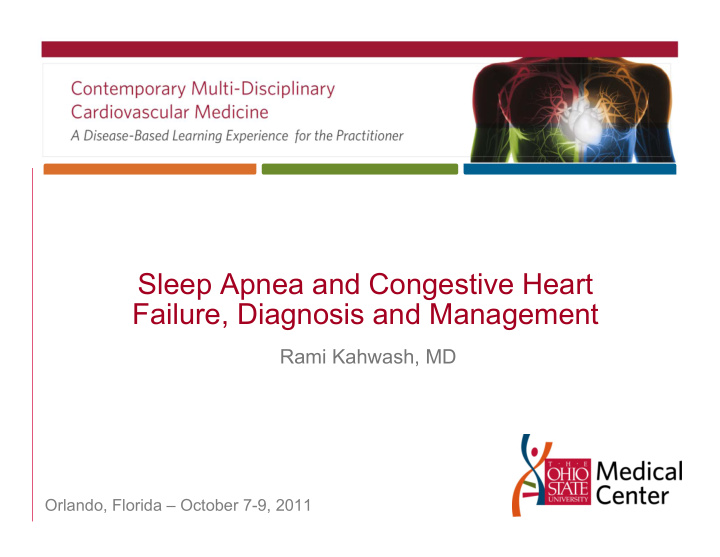



Sleep Apnea and Congestive Heart Failure, Diagnosis and Management Rami Kahwash, MD Orlando, Florida – October 7-9, 2011
Presentation Outline ♥ Overview of sleep disordered-breathing (SDB) ♥ Pathophysiology of the cardiovascular consequences of OSA and CSA ♥ Treatment of OSA-Focus on the cardiovascular impact of treatment ♥ Treatment of CSA
Case History ♥ 61 y/o commercial driver presents to the clinic with: ♥ Excessive daytime sleepiness ♥ Snoring and pauses in breathing reported by the wife ♥ Difficult to concentrate on the job!
Sleep History ♥ Seven and half hours of allowed sleep per night ♥ Tired in the morning ♥ Awakens 3-4 times at night to “use rest room” ♥ Persistent loud snoring ♥ Leg jerks and kicks- restless sleep
Case History ♥ MHX: ♥ Hypertension ♥ Hypercholesterolemia ♥ ROS: ♥ 35 lbs weight gain/past two year ♥ SoHx: ♥ 40 Pack/year
NEXT STEP POLYSYMNOGHRAPHY
EKG Airflow Thoracic effort Abd. effort SAO2
EKG Exhale Airway opens Airway obstructs Airflow Effort gradually increases Thoracic effort Paradoxing Abd. effort Paradoxing Ends Blood oxygen levels SAO2 reduce to < 4% of baseline value Obstructive Apnea: partial or complete cessation of upper airway despite continued efforts to breath
ECG ECG Airflow Airflow Thor. Thor. Effort Effort Abd. Abd. Effort Effort SAO 2 SAO 2 Central sleep apnea: cessation of upper airway flow without respiratory effort.
Sleep Medicine Nomenclatures ♥ Apnea: complete cessation of airflow > 10 seconds ♥ Hypoapnea: decrease in airflow > 30 %, longer than 10 sec, associated with decrease in O2 sat > 4 % or arousal ♥ AHI: number of events per hour ♥ 5 -15Mild ♥ 15 -30 moderate ♥ >30 severe
Prevalence of Obstructive Sleep Apnea The Wisconsin Sleep Cohort, NEJM 1993 The Occurrence of Sleep-Disordered Breathing among random 602 Middle-Aged Adults.
Prevalence in Middle Aged Adults % Men % Women AHI ≥ 5 24 9 4 2 AHI ≥ 5 + daytime somnolence AHI = Apnea Hypopnea Index Young; NEJM 1993
Prevalence of OSA in Stable Outpatients with Heart Failure
Physical Examination in OSA ♥ Malampati Class (I-IV) ♥ Obesity and thick neck ♥ > 17 inch males ♥ > 16 inch females ♥ Craniofacial anatomy ♥ Inferiorly positioned hyoid bone ♥ Mandibular insufficiency ♥ Increased mid-facial height ♥ Nasal obstruction
Mallampati Class: Independent Predictor of the Presence and Severity of OSA Nuckton et al, Sleep 2006 Mallampati class
SCHELLENBERG et al AJRCCM 2000
SCHELLENBERG et al AJRCCM 2000
Cardiovascular Consequences- Pathophysiology Caples,et al.,Sleep,Vol. 30, No.3,2007
OSA AND Hypertension ♥ 40% of patients with OSA have hypertension ♥ 50% of patients with hypertension have OSA ♥ OSA patients are more likely to be nocturnal “non-dippers” ♥ Treatment of OSA reduces blood pressure
OSA- Induced Hypertension-Animal Model Brooks, et al. J Clin Invest 99:106, 1997
OSA and CHF-the Sleep Heart Health n=6,424 E Shahar, et al, AJRCCM, 2001
SBD and Heart Failure in Clinical Practice CS Congestive heart failure A OSA Diastolic Coronary disease or Systolic hypertension dysfunctio dysfunction n OSA
Treatment of OSA ♥ Weight loss ♥ Positive airway pressure ♥ Surgery ♥ Oral appliances ♥ Oxygen
Effects of CPAP ♥ Respiratory Effects: ♥ Elimination of upper airway obstruction ♥ Unloading of respiratory muscles ♥ Improved work of breathing ♥ Improved gas exchange and elimination of desatruration
Causative Role of Severe Untreated OSA in Cardiovascular Events mean F/u 10 YR (Marin et al, Lancet 365:1046, 2005)
CPAP Improves LVEF in Patients with CHF CPAP group had a significant absolute increase of 8.8±1.6 percent in the left ventricular ejection fraction (P<0.001) Kaneko et al, NEJM 348:1233, 2003
CSA : Treatment ♥ Management of CHF ♥ Supplemental Oxygen ♥ Acetazolamide ♥ Theophylline ♥ Pacemaker ♥ Heart Transplantation
CANPAP ♥ 258 patients age 18-79 with heart failure, ejection fraction < 40%, and central sleep apnea despite optimal medical therapy ♥ Randomized. Mean age 63 years. Baseline ejection fraction 24.5% Nocturnal CPAP † Nocturnal CPAP † No CPAP No CPAP Titrated as tolerated to 10 cmH 2 O Titrated as tolerated to 10 cmH 2 O n=128 n=128 n=130 n=130 Endpoints (mean follow-up 2 years): Endpoints (mean follow-up 2 years): ♥ Primary: Death or heart transplantation ♥ Primary: Death or heart transplantation ♥ Secondary: Apnea hypopnea index, quality of life ♥ Secondary: Apnea hypopnea index, quality of life † CPAP was used an average of 4 hours per day during the trial Bradley TD et al. N Engl J Med 2005; 353:2025-2033.
CANPAP Primary Endpoint: Death or hospitalization p=0.54 ♥ Average sleep time was 304 35 35 32 32 32 32 minutes in the CPAP group 30 and 308 minutes in the control 30 group. Apnea hypopnea 25 25 index at baseline was 40 20 20 apneas/hour 15 15 ♥ There was no difference in the 10 frequency of death or 10 hospitalization between 5 5 groups or in the cumulative 0 0 number of hospitalizations nocturnal CPAP no CPAP nocturnal CPAP no CPAP (p=0.83)
SDB and Cardiovascular Diseases- Conclusions ♥ OSA has a causative relation with hypertension ♥ OSA is a independent risk factor for: ♥ Heart failure ♥ CAD ♥ Stroke ♥ Cardiac arrhythmia ♥ OSA causes worse outcomes in stroke, CAD, and Afib. Main therapy is CPAP. ♥ CSA coexist with heart failure and aggravate its control. Main therapy is optimizing HF control
Thank You
Recommend
More recommend